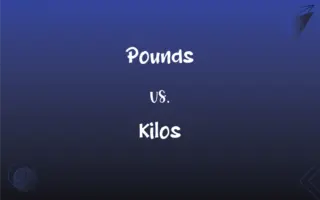Cellulose vs. Glycogen: What's the Difference?
Edited by Aimie Carlson || By Harlon Moss || Published on February 24, 2024
Cellulose is a complex carbohydrate forming plant cell walls, while glycogen is a carbohydrate serving as energy storage in animals and fungi.

Key Differences
Cellulose is a polysaccharide consisting of a linear chain of several hundred to over ten thousand linked D-glucose units. Glycogen, on the other hand, is a multi-branched polysaccharide of glucose serving as a form of energy storage in animals and fungi.
Found primarily in plants, cellulose provides structural support to cell walls. In contrast, glycogen is stored mainly in the liver and muscles of animals and serves as a quick source of energy.
The structure of cellulose is rigid and linear, contributing to the high strength of plant cell walls. Glycogen's structure is highly branched, allowing for rapid release of glucose when energy is needed.
Humans and many other animals cannot digest cellulose due to the lack of necessary enzymes. However, glycogen is easily broken down into glucose to provide energy in animals, including humans.
Cellulose is a major component of biomass and is used in various industrial applications, whereas glycogen’s role is primarily biological, being essential for energy metabolism in animals.
ADVERTISEMENT
Comparison Chart
Composition
Long chains of D-glucose
Branched chains of glucose
Location
In plant cell walls
In animal liver and muscle cells
Structure
Rigid, linear
Highly branched
Digestibility
Indigestible by humans
Easily digested for energy
Primary Function
Structural support in plants
Energy storage in animals
ADVERTISEMENT
Cellulose and Glycogen Definitions
Cellulose
Cellulose is a polymer made of glucose units linked together.
Cellulose is one of the most abundant organic polymers on Earth.
Glycogen
Glycogen is a storage form of glucose in animals and fungi.
Glycogen stored in the liver is used to regulate blood sugar levels.
Cellulose
Cellulose is indigestible to humans but is a dietary fiber.
Dietary fiber in vegetables is largely made of cellulose.
Glycogen
Glycogen is stored in the liver and muscle tissues.
The liver stores glycogen and releases glucose into the bloodstream.
Cellulose
Cellulose is used in the production of paper and textiles.
The cellulose in wood pulp is processed to make paper.
Glycogen
Glycogen is a multi-branched polysaccharide.
Glycogen's branched structure allows for rapid glucose release.
Cellulose
Cellulose can be chemically modified to produce useful materials.
Cellophane is a transparent film made from cellulose.
Glycogen
Glycogen metabolism is key in managing energy in the body.
Glycogen synthesis and breakdown are critical in energy homeostasis.
Cellulose
Cellulose is a complex carbohydrate that forms the structure of plant cell walls.
The cellulose in plant cell walls gives them rigidity and strength.
Glycogen
Glycogen serves as a quick energy source.
During exercise, muscles use glycogen for immediate energy.
Cellulose
A polysaccharide, (C6H10O5)n, that is composed of glucose monomers and is the main constituent of the cell walls of plants. It is used in the manufacture of numerous products, including paper, textiles, pharmaceuticals, and insulation.
Glycogen
A polysaccharide, (C6H10O5)n, that is the main form of carbohydrate storage in animals and is found primarily in the liver and muscle tissue. It is readily converted to glucose as needed by the body to satisfy its energy needs. Also called animal starch.
Cellulose
A complex carbohydrate that forms the main constituent of the cell wall in most plants and is important in the manufacture of numerous products, such as paper, textiles, pharmaceuticals, and explosives.
Glycogen
(carbohydrate) A polysaccharide that is the main form of carbohydrate storage in animals; converted to glucose as needed.
Cellulose
(organic compound) A polysaccharide containing many glucose units in parallel chains.
Glycogen
A white, amorphous, tasteless substance resembling starch, soluble in water to an opalescent fluid. It is found abundantly in the liver of most animals, and in small quantity in other organs and tissues, particularly in the embryo. It is quickly changed into sugar when boiled with dilute sulphuric or hydrochloric acid, and also by the action of amylolytic ferments.
Cellulose
Consisting of, or containing, cells.
Glycogen
One form in which body fuel is stored; stored primarily in the liver and broken down into glucose when needed by the body
Cellulose
Consisting of, or containing, cells.
Cellulose
The substance which constitutes the essential part of the solid framework of plants, of ordinary wood, cotton, linen, paper, etc. It is also found to a slight extent in certain animals, as the tunicates. It is a carbohydrate, (C6H10O5)n, isomeric with starch, and is convertible into starches and sugars by the action of heat and acids. When pure, it is a white amorphous mass. See Starch, Granulose, Lignin.
Unsized, well bleached linen paper is merely pure cellulose.
Cellulose
A polysaccharide that is the chief constituent of all plant tissues and fibers
FAQs
What is cellulose primarily composed of?
Cellulose is composed of long chains of D-glucose units.
Where is glycogen primarily stored in the body?
Glycogen is primarily stored in the liver and muscle tissues.
Can humans digest cellulose?
No, humans cannot digest cellulose; it acts as dietary fiber.
What industrial uses does cellulose have?
Cellulose is used in papermaking, textiles, and as a food additive.
Is glycogen found in plants?
No, glycogen is not found in plants; it's in animals and fungi.
What is the main function of glycogen?
The main function of glycogen is to store energy in animals.
How is cellulose important in plants?
Cellulose provides structural support to plant cell walls.
What is a common source of cellulose in the diet?
Vegetables and whole grains are common dietary sources of cellulose.
Is cellulose a simple or complex carbohydrate?
Cellulose is a complex carbohydrate.
What happens to glycogen during fasting?
During fasting, glycogen stores are broken down to release glucose.
Can cellulose be digested by any animals?
Some animals, like termites and ruminants, can digest cellulose with specialized gut bacteria.
What role does glycogen play in muscle function?
Glycogen provides energy for muscle contraction during physical activity.
How does the body use glycogen during sleep?
The body uses glycogen stores to maintain blood sugar levels during sleep.
How is glycogen used during exercise?
Glycogen is broken down to provide quick energy during exercise.
Does glycogen play a role in blood sugar regulation?
Yes, glycogen in the liver helps regulate blood sugar levels.
Can animals store glycogen?
Yes, animals store glycogen in their liver and muscles.
Is cellulose used in dietary supplements?
Yes, cellulose is often used in dietary supplements as a fiber source.
Is cellulose ever used in clothing?
Yes, cellulose fibers are used in the production of fabrics like cotton and rayon.
Are cellulose and glycogen chemically similar?
Both are polysaccharides of glucose but have different structures and functions.
Does glycogen have any role in brain function?
Glycogen in the brain provides an energy reserve for neuronal activity.
About Author
Written by
Harlon MossHarlon is a seasoned quality moderator and accomplished content writer for Difference Wiki. An alumnus of the prestigious University of California, he earned his degree in Computer Science. Leveraging his academic background, Harlon brings a meticulous and informed perspective to his work, ensuring content accuracy and excellence.
Edited by
Aimie CarlsonAimie Carlson, holding a master's degree in English literature, is a fervent English language enthusiast. She lends her writing talents to Difference Wiki, a prominent website that specializes in comparisons, offering readers insightful analyses that both captivate and inform.






































































